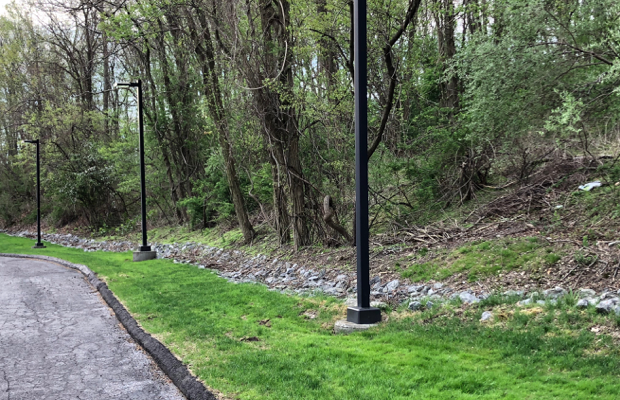With spring weather and longer days, pedestrian-friendly outdoor spaces are back in business.
For many properties, landscaped open spaces pulls the business together. Open air verandas, greenways for biking and interconnected systems of nature paths and walkways can often become the heartbeat of your campus.
Our harsh winter, however, may have left your grounds in need of repair. Excess water, from abundant snow melt can lead to drainage problems above and below the surface. Sunken pavers or damaged pavements and cracks in retaining walls are problems that are easy to spot on a walk-through.
Sometimes issues that are minor are more extensive that you might think. We can diagnose potential problems and help you decide what to tackle first.
To keep it simple, we recommend the following list of freshening projects and repair solutions that will deliver the greatest return on your investment.
Plant more trees: Trees are one of the few plants that continue to add sustainable economic value, long after other plants outlive their peak performance. They absorb pollutants, improve air quality, regulate air temperature, and their root systems add nutrients to the soil and anchor the landscape to reduce rates of erosion.
Reimagine lawns: High performing lawn alternatives include replacing traditional or under-utilized lawn areas with perennial meadows, planting foot-friendly ground covers, and installing wide herbaceous borders planted with ornamental grasses and shrubs to add interest.
Improve outdoor work spaces: On corporate sites, outdoor rooms, covered patios, terraces, above grade decks, and recreational amenities are shaping the new integrated work space. Bocce ball and sports courts, roof top gardens, and courtyards encourage employee social interaction and productivity. Privacy screens using strategic plant material provide quiet work area alternatives and warm weather collaboration space.
Reduce environmental impacts:
Pedestrian friendly is also bike friendly. Bolster the health benefits your stakeholders receive from your property with bike paths, racks and storage areas. Use reclaimed masonry and lumber to refresh built elements; monitor water usage through high tech digital systems; control drainage and erosion problems to protect ground water quality; restore habitat areas to attract pollinators and beneficial insects; and modify streams to protect estuaries, and riparian corridors.
Create accessibility:
ADA-compliant improvements in benches, walkways, ramps, and parking surfaces help corporate properties be inclusive to all individuals. Rehabilitate facades, upgrade signage, walkways and medians, with improved safety lighting will significantly increase market value.
Boost image:
The exterior of your building is the first impression people have. Exterior areas that are inviting, interactive, and vibrant with flowers and trees, and use an interesting mix of building materials, send a message that speaks to the quality and spirit of your brand while complementing the look and feel of your property.
Get LEED® certified:
Landscape improvements can qualify for LEED® by improving soil, addressing water efficiency and drainage, and the strategic use of plants and trees. Our ecologically sound principles for maintenance, and maintenance practices, which include the proper application and use of nutrients and chemical alternatives to reduce toxicity, are critical to achieving green credits for energy efficiency.
As corporate campuses adapt to changing needs, ELM can help property owners and managers revitalize landscapes and assist in the planning of hardscape improvements to coordinates with other site infrastructure upgrades, as well as implement programs for annual repair and maintenance.
For more information on re-energizing your landscape, support LEED® goals, or simply to offer your employees a thriving integrated outdoor space, contact Bruce Moore Jr., vice president operations at 203.316.5433
Photo caption: Ecological restoration projects are win-wins that benefit habitat biodiversity and serve corporate sustainability goals. ELM created a healthier waterway in this stream reclamation project by re-directing the creek’s flow, re-building the stream bed and its banks as part of a drainage swale project for Oracle Corporation in Stamford. © ELM.
Follow us on Facebook

